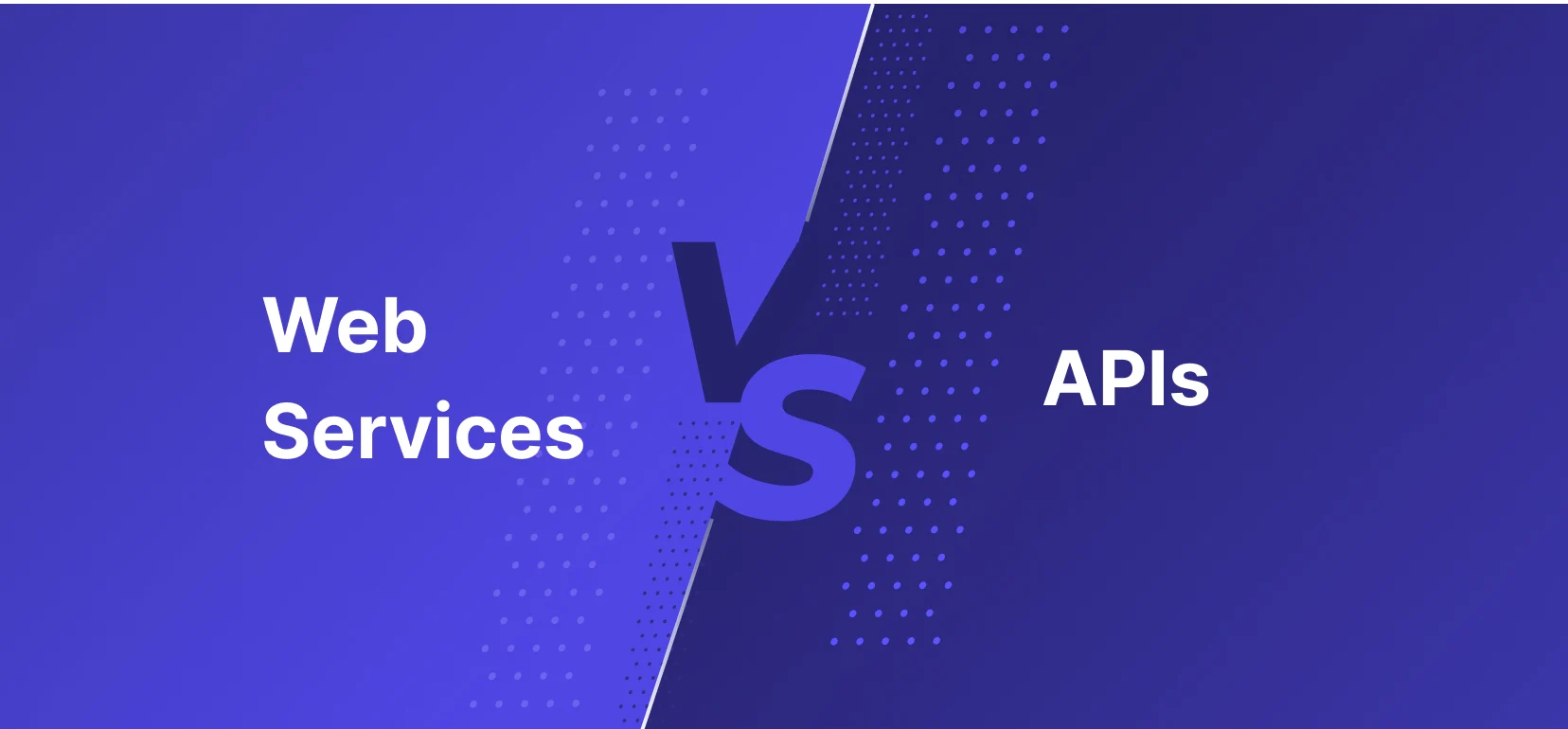- MACH
Web Services vs. API: Differences, Similarities, and Everything You Need to Know


Web Services vs. API; A question that comes to everyone's mind and should be asked. However, these are two very distinct things. Before diving into them, first, we need to define the service.
A service is a standalone, independently deployable software component that implements some useful functionality. [1]
Although there is a web in the web services, they are not only used on the web. This is perhaps a slight misnomer.
When HTTP is used as the underlying protocol for talking to the service, it is called a web service. This is why web services are not only used on the web but also in several different contexts. For example:
A client application running on a user’s device (native mobile app, JavaScript web app, etc.) makes requests to a service over HTTP.
One service makes requests to another service owned by the same organization, often located within the same data center (like Service oriented architecture or Microservice architecture)
One service making requests to a service owned by a different organization, usu‐ ally via the internet.
On the other hand, an API is a set of protocols, routines, and tools for building software applications. It allows different components to communicate and, like documentation, shows how software components should interact with each other. It defines the way in which these components communicate with each other.
Now the question is, how related are these two?
All web services are APIs, but not all APIs are web services. APIs can be implemented for various purposes, such as accessing a database or controlling a device, while web services specifically refer to APIs that are accessible over the internet using HTTP.
Let's talk in more detail.
What Is a Web Service?
Web services are a specific type of API that facilitate interactions through HTTP.
Before going into the details of the web service, we should look at and understand what the IPC (inter-process communication) is.
If we look carefully at the “IPC” word, we will see that there is communication in it. We have to expand what communication is.
The processes (such as clients and servers) want to communicate with each other for some purpose, like data transferring, some functionality, etc. This defines the IPC Mechanism.
In order for processes to communicate, they need to agree on a set of rules that determine how data is processed and formatted. This defines the API.
In the Web Service context, the communication is only HTTP. So we can continue to focus on HTTP-based IPC technologies and their API.
The two most popular of them are REST and gRPC.
REST
REST is really a style, or way of doing, that Roy Fielding, the creator of REST, documented to help software architects and programmers build robust, reliable, and scalable applications and APIs. You can find more detail in our article.
Because we already defined the REST and its use case in more detail, we will only introduce the gRPC and its API in this article.
gRPC
First, let’s define RPC, which has existed since the 1970s.
RPC stands for Remote Procedure Call, which is a protocol used to enable communication between different processes or applications running on different machines over a network. RPC allows a client to call a function or procedure on a remote server, and receive the result as if it were executed locally.
The basic idea behind RPC is that a client sends a request message to a remote server, which processes the request and sends a response message back to the client. The client and server can be written in different programming languages and run on different operating systems.
What Is gRPC?
gRPC is a high-performance open-source Remote Procedure Call (RPC) framework originally developed by Google. It uses Protocol Buffers, a language-agnostic binary serialization format, as its primary data format and supports multiple programming languages such as Java, C#, NodeJS, and Go.
gRPC enables efficient communication between distributed systems by leveraging HTTP/2 as a transport protocol, which allows bidirectional streaming, multiplexing, and flow control. This makes gRPC faster and more efficient than traditional REST APIs, as it can simultaneously handle multiple requests and responses over a single connection.
gRPC also supports bi-directional streaming, enabling the server to stream data back to the client while the client still sends data to the server. This allows for real-time applications such as chat applications and online gaming.
The framework provides automatic code generation for clients and servers, which makes it easier to use and reduces the amount of boilerplate code required.
syntax = "proto3"
package todoPackage;
service Todo {
rpc createTodo(TodoItem) returns (TodoItem);
rpc readTodos(voidNoParam) returns (TodoItems);
rpc readTodosStream(voidNoParam) returns (stream TodoItem)
}
message voidNoParam {}
message TodoItem {
int32 id = 1;
string text = 2;
}
message TodoItems {
repeated TodoItem items = 1;
}Advantages of gRPC
Fast and Efficient Communication: gRPC is built on top of HTTP/2, which allows for bidirectional streaming, multiplexing, and flow control. This means that gRPC can send multiple requests and responses at the same time, making communication faster and more efficient.
Language Agnostic: gRPC supports multiple programming languages, including Java, C#, NodeJS, Go, and more. This makes integrating gRPC with existing applications written in different languages easy.
Code Generation: gRPC uses protocol buffers to define its service contracts, and it generates code for each supported language. This makes it easy to use and integrate with other tools and frameworks.
Disadvantages of gRPC
Learning Curve: gRPC has a steep learning curve, especially for developers who are not familiar with protocol buffers and RPC concepts.
Limited Browser Support: gRPC does not work in all browsers, as it requires HTTP/2 support, which is not yet widely available.
Debugging: Debugging gRPC can be challenging, especially when working with complex systems.
A Brief Overview of API
API is a set of protocols, routines, and tools for building software applications. It allows different components to communicate and shows them how they should interact with each other. It is like a documentation which defines the way in which these components communicate with each other.
We explained what API and its use cases previous article; you can check it for more details!
Today, we will only focus on the similarities and differences between web services and API.
Similarities Between Web Services and API
Both APIs and Web Services allow different software systems to communicate with each other and share data.
Both can be used to expose the functionality of a software system to developers, allowing them to integrate that functionality into their own applications.
Both can use various data formats, such as JSON and XML, to exchange data between systems.
Both can be accessed remotely over a network.
Differences Between Web Services and API
APIs are generally used to expose the functionality of a software system to developers, while Web Services are designed to support interoperable machine-to-machine interaction over a network.
APIs can be accessed via multiple channels such as web browsers, command-line interfaces, mobile apps, etc., while Web Services are typically accessed over the internet via HTTP.
Web Services are designed to be platform-agnostic and can be used by applications written in different programming languages and running on different operating systems, while APIs may require some level of customization to work across different platforms.
In summary, while APIs and Web Services share some similarities in terms of their purpose, ability to exchange data, and remote accessibility, they also have significant differences in terms of the technology used, standards followed, and their intended use cases.
While all web services are APIs, not all APIs are web services.
APIs can be implemented for various purposes, such as accessing a database or controlling a device, while web services specifically refer to APIs that are accessible over the internet using HTTP or other communication protocols.
Frequently Asked Questions About Web Services vs. APIs
What Is the Difference Between Web Service and API?
In summary, while both web services and APIs provide a means for software applications to communicate with each other, web services are a specific type of API that facilitate interactions through HTTP.
Is Web Service and REST API the Same?
REST APIs and Web Service APIs are related, but they are not the same thing. In fact, REST APIs are a type of Web Service API. In summary, Web Service APIs and REST APIs are related but not interchangeable. REST APIs are a specific type of Web Service API that follows a standardized architecture style for handling resource requests and responses using HTTP protocols.
Does the Term API Refer to Web Service?
While web services are one of the most common examples of APIs, not all APIs refer to web services, an API can be used, a general term, for communication between any two software applications, while Web Services are APIs that use HTTP as the underlying protocol. Therefore, the term API does not solely refer to web services but encompasses a wider range of communication protocols between software applications.
Learn everything you need to know about MACH architecture

